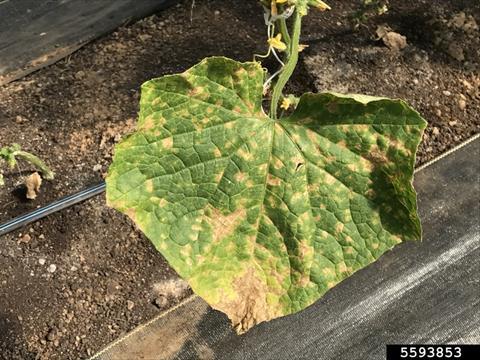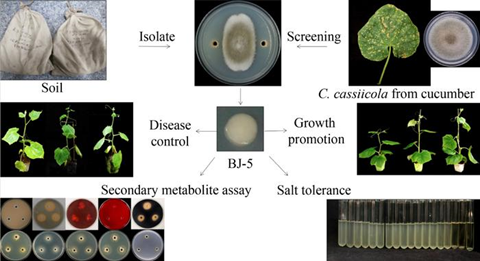In order to meet market demand throughout the year, cucumber is mainly planted in facility greenhouses. However, the loss of soil nutrients and the accumulation of pathogenic microorganisms are inevitable in successive years of cultivation.

Cucumber corynespora leaf spot, also known as cucumber target spot disease, is a major foliar disease that causes cucumber yield reduction, and its pathogen is the Corynespora cassiicola. The pathogen harms cucumber leaves, causing irregular spots and affecting the photosynthesis of cucumber.
READ MORE: Mycoviruses enhance fungicide effectiveness against plant pathogens
READ MORE: Unpeeling the layers - what my summer placement taught me about onion rot and lab life
Under high temperature and high humidity, the conidia of C. cassiicola can directly penetrate the epidermis of the host leaf blade through germination and production of bud tubes, or invade the host through stomata and natural wounds, causing the host to develop.
Environmental impacts
At present, the control of plant fungal diseases mainly relies on agrochemicals and cultivation measures, but due to the frequent use of pesticides, resistance of pathogens has subsequently emerged and the effectiveness of fungicides has decreased. At the same time, consumers are increasingly concerned about the environmental impacts and food residues of fungicides.
Therefore, there is an urgent need for methods that can replace chemical pesticides in the control of plant diseases. Biological control offers a viable solution for plant disease management and is an environmentally friendly method that promotes disease management while maintaining ecosystem balance.
Through biological control, plant diseases can be effectively controlled without disturbing the natural balance of flora and fauna. In addition, this method improves soil fertility and is an important tool for sustainable agriculture.
Biocontrol strain
In order to achieve the goal of pollution-free and environmentally friendly, this study screened a biocontrol bacterial strain BJ-5 using Corynespora cassiicola as the target pathogen, and BJ-5 was determined to be Paenarthrobacter nitroguajacolicus by morphological and molecular methods. The effect of BJ-5 on C. cassiicola was studied, including the spore germination, cell membrane permeability, and infected cucumbers.
BJ-5 inhibited the germination of C. cassiicola spores in vitro and led to atrophy and deformation of the C. cassiicola budding tubes. BJ-5 caused the relative extracellular conductivity of C. cassiicola mycelia to increase compared with the control. Additionally, BJ-5 reduced the severity of cucumber corynespora leaf spot of cucumber infected with C. cassiicola.

The inhibition efficacy of BJ-5 suspension as a foliar spray against cucumber corynespora leaf spot reached 63% inhibition, which is higher than a 5000-fold dilution of Luna-Son SC fungicide. In addition, BJ-5 was tested on the emergence of cucumber seedlings, recording the biomass and photosynthesis of cucumber during the growth period. BJ-5 at 1.5 × 105 CFU·mL–1 promoted the germination of cucumber seeds and increased biomass and photosynthesis at the adult plant stage.
Adaptable solution
Also, the secondary metabolites of BJ-5 were determined. BJ-5 could produce chitinases, siderophore, cellulase, amylase, and protease in the respective medium. Finally, adaptation assay of BJ-5 showed good salt tolerance and good adaptability in alkaline conditions, and that BJ-5 retains inhibition of fungi activity at higher temperatures.
When controlling harmful microorganisms in production, attention should be paid to the impact of pesticides on the environment. Finding natural methods to control harmful microorganisms has great potential and is environmentally friendly.
This is the first report of biocontrol by P. nitroguajacolicus with antagonism to C. cassiicola and promotion of cucumber growth and indicates that P. nitroguajacolicus may serve as potential biocontrol agents against cucumber corynespora leaf spot fungus.

No comments yet